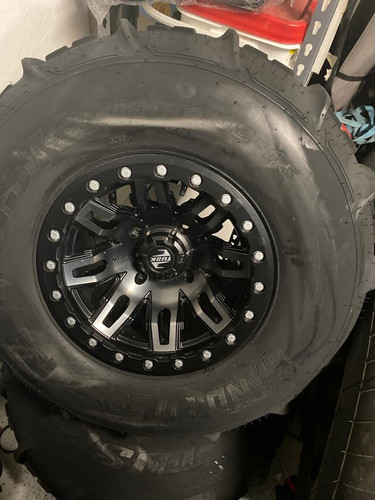Buyer's Guide: Factory Specs For The Can-Am Defender, Commander, And Maverick Tire Size, Wheel Size, Wheel Offset, And Bolt Pattern
Oct 29th 2020
Whatever you and your Can-Am side-by-side get into together, it pays to know a bit about your machine. To make your investment last longer, knowing both when and how to undertake maintenance, upkeep, and servicing is vital. And before you alter, adjust, or swap out your factory Can-Am tires and wheels, it pays to know what the stock specifications are. After all, there’s more to a UTV tire than its height, and an aluminum vs a steel rim is but one of many factors to consider. So regardless of which Can-Am UTV you own, here are the stock tire sizes, wheel sizes, wheel offsets, and bolt patterns of the Can-Am Commander, Can-Am Defender, and Can-Am Maverick.
Stock Tire and Wheel Specs for The Can-Am Commander

The stock bolt pattern on the wheels hubs of all Can-Am UTVs (including the Commander) is 4/137. This is the same bolt pattern as many Kawasaki UTVs, whereas Polaris vehicles typically use a 4/156 bolt pattern -- meaning that if you’re looking to run rims with non-conforming bolt patterns, you’re going to need a wheel adapter.
Where lugs are concerned, the stock Can-Am Commander lug nuts measure 10mm x 1.25, with the latter number indicating the pitch of the thread. As far as torque specs go, tightening your lug nuts to anything less than 74 foot-pounds could lead to issues like broken studs. And this is not to be confused with the torque specs for beadlock rims, which are 27 inch-pounds. When in doubt, follow the torque specs of the German automakers and make sure your lugs are “guten tight”!
Depending on your specific Can-Am Commander model, your stock tires and wheels will either be 27x9-12 in the front and 27x11-12 in the rear, or 27x9-14 in the front and 27x11-14 in the rear. The 2020 Can-Am Commanders that come with larger 14” wheels include the Commander DPS, the Commander XT, and the Commander Limited as well as their corresponding “MAX” four-door counterparts.
Stock Tire And Wheel Specs For The Can-Am Defender

The Can-Am Defender bolt pattern and lug nut size is the same as the Can-Am Commander, with a 4/137 bolt pattern and 10mm x 1.25 lug nuts. The stock wheel offset is the same for all Can-Am UTVs as well, 4+3. Different Can-Am Defender packages come with different sizes of tires and wheels. Aside from the Defender MAX X-MR HD10 — which comes stock with 30” tires — the other Defender editions have factory tires that measure between 25 inches and 28 inches in diameter, with an overwhelming majority falling in the 27-inch category. Where tire width is concerned, stock Can-Am Defender tires are either 9 inches wide in the front and 11 inches wide in the back, or 8 inches wide in the front and 10 inches wide in the back. Stock Can-Am Defender wheels are either 12 inches or 14 inches, with a 7-inch or 8-inch width.
Stock Tire And Wheel Specs For The Can-Am Maverick

The only difference in the bolt pattern and lug nut size between the Maverick and the other Can-Am UTVs exists exclusively with the Maverick X3. Instead of the standard 10mm x 1.24 studs, the Can-Am Maverick uses 12mm studs. Most of the Maverick X3 editions come with 30” tires and 14” rims, the Maverick X3 Turbo RR X RC being the exception with its stock 32” tires and 15” rims.
The non-X3 Mavericks come with a stock tire size of either 27x9-12 in the front and 27x11-12 in the rear, or 28x9-14 in the front and 28x11-14 in the rear. And unlike the other models, the RC editions of the Can-Am Maverick X3 have the same tire width on the front and back. If you think about it, this makes sense, as the RC model of the Can-Am Maverick X3 is made for rock crawling, and doesn’t require a skinnier tire in the front for less resistance on mud or hard-pack.
Deviating From Stock Tire And Wheel Specs

When straying from factory Can-Am tires and wheels, unanticipated results may arise. Go too big with your wheels or tires without clutch modifications and you could see power reductions and slower engagements. Furthermore, maintenance will become increasingly important if you depart from stock Can-Am tire and wheel specs. You could see more rapid wear in your wheel bearings, brakes, and tie-rod ends, with the front end being more problematic than the rear. Keeping an eye on your machine is always important, but it is increasingly so if you change up your tires and wheels. At the end of the day, however, the decision to alter your bike lies with you. And like everything in life, it would behoove you to weigh the pros and cons before making any purchase decision!


